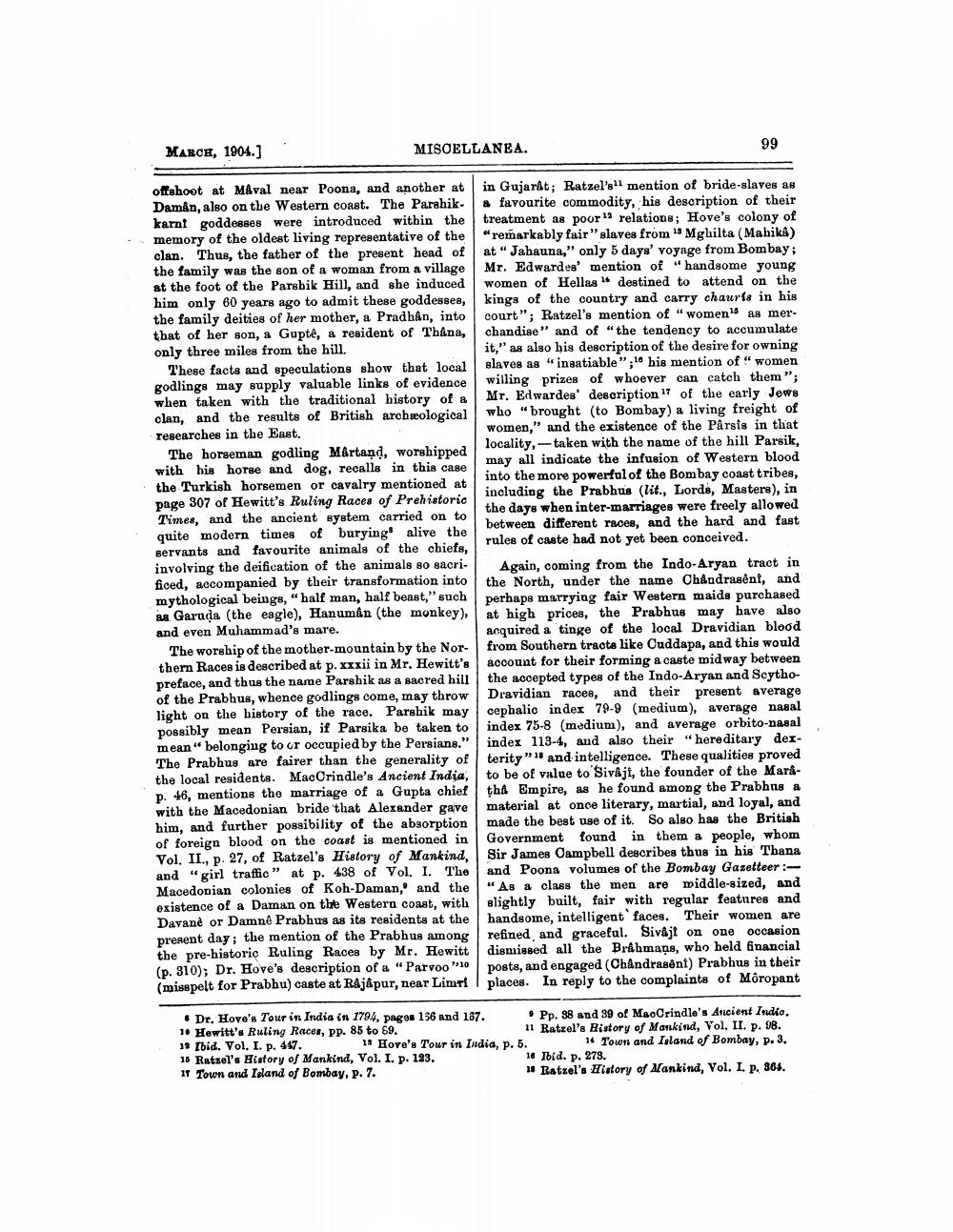________________
MARCE, 1904.)
MISCELLANEA.
99
offshoot at Mával near Poona, and another at in Gujarat; Ratzel's mention of bride-slaves as Damân, also on the Western coast. The Parshik. & favourite commodity, his description of their karnt goddesses were introduced within the treatment as poor" relations; Hove's colony of memory of the oldest living representative of the "remarkably fair" slaves from "Mghilta (Mahika) clan. Thus, the father of the present head of at "Jahauna," only 5 days' voyage from Bombay; the family was the son of a woman from a village Mr. Edwardes' mention of "handsome young at the foot of the Parsbik Hill, and she induced women of Hellas destined to attend on the him only 60 years ago to admit these goddesses, kings of the country and carry chauris in his the family deities of her mother, a Pradhan, into court"; Ratzel's mention of "women's as merthat of her son, a Guptê, a resident of Thana, chandise” and of "the tendency to accumulate only three miles from the hill.
it," as also his description of the desire for owning These facts and speculations show that local slaves as "insatiable";' his mention of "women godlings may supply valuable links of evidence willing prizes of whoever can catch them "; when taken with the traditional history of a Mr. Edwardes' description 17 of the early Jews clan, and the results of British archæological who "brought (to Bombay) a living freight of researches in the East.
women," and the existence of the Pârsis in that The horseman godling Mårtand, worshipped
locality, -taken with the name of the hill Parsik, with his horse and dog, recalls in this case
may all indicate the infusion of Western blood
into the more powerful of the Bombay coast tribes, horsemen or cavalry mentioned at page 307 of Hewitt's Ruling Races of Prehistoric
including the Prabhus (lit., Lords, Masters), in Times, and the ancient system carried on to
the days when inter-marriages were freely allowed quite modern times of burying alive the
between different races, and the hard and fast servants and favourite animals of the chiefs,
rules of caste had not yet been conceived. involving the deification of the animals so sacri. Again, coming from the Indo-Aryan tract in ficed, accompanied by their transformation into the North, under the name Chandrasent, and mythological beings,"half man, half beast," such perhaps marrying fair Western maids purchased as Garuda (the eagle), Hanuman (the monkey), at high prices, the Prabhus may have also and even Muhammad's mare.
acquired a tinge of the local Dravidian blood The worship of the mother-mountain by the Nor- from Southern tracta like Cuddapa, and this would thern Races is described at p. xxxii in Mr. Hewitt's account for their forming a caste midway between preface, and thus the name Parshik as a sacred hill the accepted types of the Indo-Aryan and Scythoof the Prabhus, whenoe godlings come, may throw Dravidian races, and their present average light on the history of the race. Parshik may cephalic index 79-9 (medium), average nasal possibly mean Persian, if Parsika be taken to index 75-8 (medium), and average orbito-nasal mean" belonging to or occupied by the Persiana," index 113-4, and also their "hereditary derThe Prabhus are fairer than the generality of | terity "1! and intelligence. These qualities proved the local residents. MacOrindle's Ancient India, to be of value to Sivajt, the founder of the Marap. 46, mentions tho marriage of a Gupta chief the Empire, as he found among the Prabhuis a with the Macedonian bride that Alexander gave material at once literary, martial, and loyal, and him, and further possibility of the absorption made the best use of it. So also has the British of foreign blood on the coast is mentioned in Government found in them & people, whom Vol. II., p. 27, of Ratzel's History of Mankind, Sir James Campbell describes thus in his Thana and "girl traffic" at p. 438 of Vol. I. The and Poona volumes of the Bombay Gazetteer: Macedonian colonies of Koh-Daman, and the "As a class the men are widdle-sized, and existence of a Daman on the Western coast, with slightly built, fair with regular features and Davanè or Damné Prabhus as its residents at the handsome, intelligent faces. Their women are present day; the mention of the Prabhus among refined and graceful. Sivajt on one occasion the pre-historic Ruling Races by Mr. Hewitt dismissed all the Brahmans, who held financial (p. 310); Dr. Hove's description of a "Parvoo "10 posts, and engaged (Chandrasent) Prabhus in their (misspelt for Prabhu) caste at Rajapur, near Limri l places. In reply to the complaints of Môropant
• Dr. Hove's Tour in India in 1794, page 136 and 187. Pp. 38 and 39 of MaoCrindle's Ancient Indio. 10 Hewitt's Ruling Races, PP. 85 to 69.
11 Ratzel's History of Mankind, Vol. II. p. 18. 19 Toid. Vol. I. p. 417. 11 Hove's Tour in India, P. 5.
Town and Island of Bombay, p. 3. 16 Ratzel's History of Mankind, Vol. I. p. 123.
16 Ibid. p. 279. IT Town and Island of Bombay, p. 7.
Ratzel's History of Nankind, Vol. I. p. 364.




